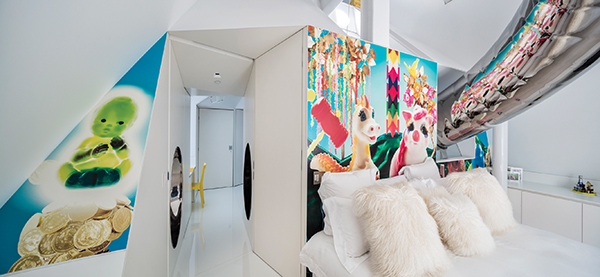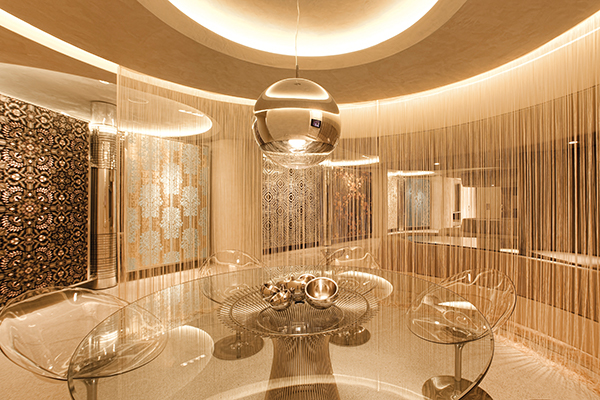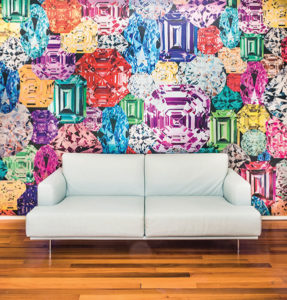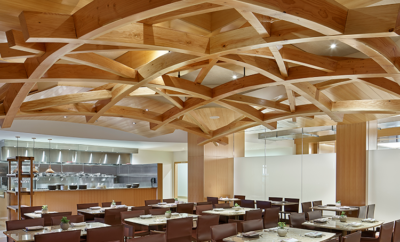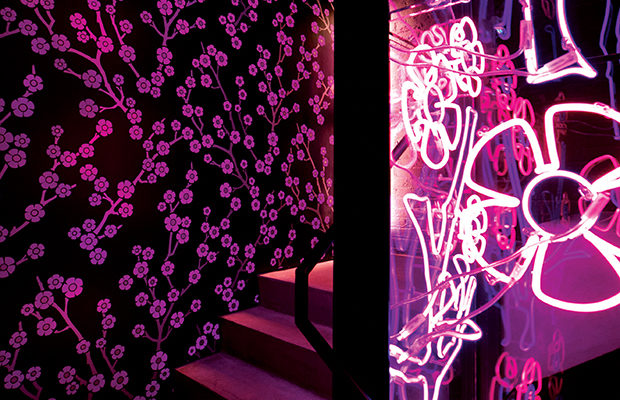 Sakura by Emily Minnie, 2008, lines the stairwell of Flavor Paper’s headquarters in Brooklyn, alongside a blown-up version of the pattern rendered in neon.
Sakura by Emily Minnie, 2008, lines the stairwell of Flavor Paper’s headquarters in Brooklyn, alongside a blown-up version of the pattern rendered in neon.
Design
Works on Paper
KNOWN FOR ITS RADICAL DAY-GLO colors, scratch-and-sniff papers, and edgy motifs, Flavor Paper has revolutionized the wallpaper industry, from its bold designs to even the way wallpaper is sold. Perhaps not surprisingly, Jon Sherman, the renaissance man behind the company, followed quite an eclectic professional path; but it prepared him well for the task of turning creative ideas into realities. Today you can find Flavor Paper in award-winning interior design projects, in art installations in top museums, and at trade shows all over the world. But to get there was quite a journey.

Gold, Fool by Jon Sherman and Boone Speed, 2017, is a mural made from a macro photograph of pyrite, printed on Mylar.
Sherman’s background includes a degree in environmental science, deejaying stints, working as a private chef, time at a computer consulting company for creatives, and a master’s in business administration from Tulane with, appropriately, a focus on entrepreneurship. Years later, in the early 2000s, when he was living in New Orleans but working on a project flipping condos in Miami, an interior design friend showed him a wallpaper she was trying to get for a client but was struggling to locate. Sherman tracked down the manufacturer, and as soon as he saw the firm’s whimsical designs, he was captivated. As the owner of a collection of vintage silkscreen posters and lover of record-cover art, he felt a certain aesthetic kinship. “They printed a lot on Mylar, very ’70s graphics, marbleized paper, things that were very different from anything I’d seen. I don’t like white walls and it all seemed to me very novel and interesting, timely and current,” he says. Thus he decided to seek the firm out in Oregon. There he discovered that the company was not only going out of business but was in the process of burning the inventory. Seeing the potential for a new creative business venture, Sherman rescued the equipment and moved it to New Orleans. And just like that, he was in the wallpaper business, not knowing a thing about the industry but trusting his instincts. “It was some serious risk-taking, combined with identifying a lack of something in the marketplace that seemed like people wanted,” he explains.
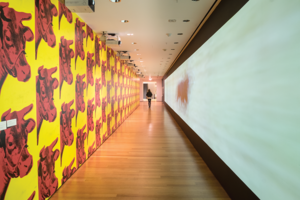
Warhol Cow Paper, based on Elaine Sturtevant’s hand-screened version of Andy Warhol’s artwork, was included in her 2014–2015 MoMA retrospective.
His instincts were right and his gamble paid off. But not without some serious challenges. Once all the equipment was settled in New Orleans—a process that involved having to perfectly level the forty-eight-foot-long flatbed vacuum-printing table and employing an ancient shipbuilding technique for straightening masts with piano wire—Sherman had to figure out how to get his wallpaper company off the ground. The night before printing his first big job—for Lenny Kravitz’s New Orleans home—one of the heaters burst into flames. Firemen controlled the fire but the computers, equipment, and paper stocks were all ruined, rendering the incipient wallpaper manufacturer unable to produce.
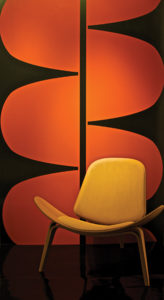
Alvorada, 2009, is a hand-screened wallpaper from the Tropicalismo collection, created with Kravitz Design.
Somehow, Sherman managed to pull it all together—and not only delivered the job but also made it to the International Contemporary Furniture Fair (ICFF) that year, 2004, where a new generation of designers took notice of his designs. “People were really responsive to the more wild designs; it seemed like there was enough tame wallpaper out there that nobody really cared to see any more of that. So it was the fun, funky stuff that was catching people’s attention,” Sherman recalls.
Warm market reception aside, the challenges still kept coming: a train crash near the warehouse knocked down power lines, which fell through the roof and blew all the electronics again. And less than a year later, Hurricane Katrina hit. “In our first couple years we had a flood, a fire, a train wreck, and a hurricane,” Sherman says. But by that point, Flavor Paper had attracted enough attention from the right people to fuel his motivation to keep going—with even greater determination and bigger ideas.
Realizing that the market and energy for his business were coming mostly from New York City, Sherman decided to move the company there, settling in an old parking garage that was being used as a beer store in the Boerum Hill section of Brooklyn. He embarked on a complete renovation of the building, transforming it into a mix of showroom, workshop, offices, and living quarters above, with the resulting design by Skylab Architecture winning a Best of Year award from Interior Design magazine.
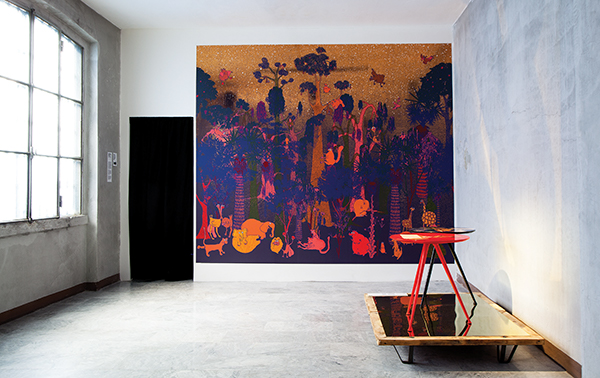
Animal Party, a screenprint mural created with the Haas Brothers for Wallpaper* Handmade in Milan in 2014, was blacklight responsive and glowed in the dark.
Organically, a cult following began to develop, with more and more artists, designers, and media becoming “Flavor” aficionados. Speaking of this phenomenon, Sherman says: “I think it was due to our irreverence towards wallpaper, the way we turned it on its head, didn’t pay attention to any of the norms, and broke all the rules. We were one of the first to sell directly to the trade and consumers at the same time, and some people were not happy about that. But I decided I was gonna sell to whoever wanted to buy. And now this is done by almost all new wallpaper companies.”
Another important element that contributed to the company’s success is the artist and designer collaborations Sherman has developed. Dan Funderburgh was one of the first artists he reached out to. “I had seen his work on the overleaf of a graffiti book where he had taken a very traditional flowery design and re-interpreted it with some really cutting-edge imagery, but within that timeless design construct—and that was exactly what I was looking for.” Several other collaborations with high profile names followed, such the Tropicalismo collection with Kravitz Design and the Verdant Vine and Dot Matrix collections by celebrated graphic designer Milton Glaser.
More recently, he paired up with French designer François Chambard from UM Projects to expand Flavor Paper’s range to include waterbased conductive inks, light, and sound to produce immersive, interactive environments. “We worked together extensively, integrating pattern and design to create playful experiences,” Sherman says. The project, a one-off installation called Conduct, also incorporates pieces of the Wild Thing paper designed by Ghislaine Viñas and went on to win the Best in Technology award during NYCxDesign in 2017. Flavor Paper’s newest collection fits right into the social-political zeitgeist. It’s called Fempower and is made exclusively of designs by women. “We had been working with these really interesting female designers independently for awhile, and with the resistance political movement we thought it was important and time to pay our due to that, showing their different perspectives, different techniques,” Sherman says. The collection, which was launched on March 8—International Women’s Day—at the Flavor Paper headquarters, features designs by Katie Stout, Natalie Gwen Frank, Ashley Longshore, Tamara Staples, and Shyama Golden.
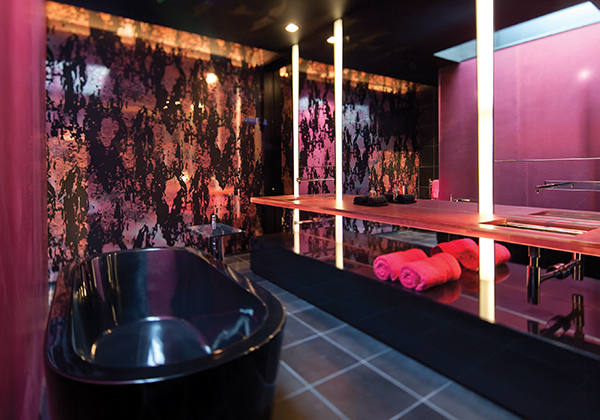
Jon Sherman’s bathroom features Celestial Dragon by Karen Hsu, 2008, colored to look like you’ve chiseled through black tile to reveal a mystic mirror.
The company continues to expand physically as well, opening a new workshop last year in Industry City that is dedicated to digital printing, and where Sherman plans to develop new techniques combining silkscreen and digital processes. But regardless of the execution or process, the company’s vision will remain the same: “Our goal is to continue to grow what we can do on wallpaper, continue to evolve what wallpaper can and should be, take every traditional wallpaper style and ‘flavor’ it up.”


